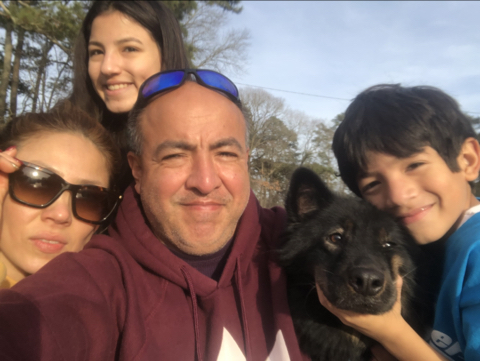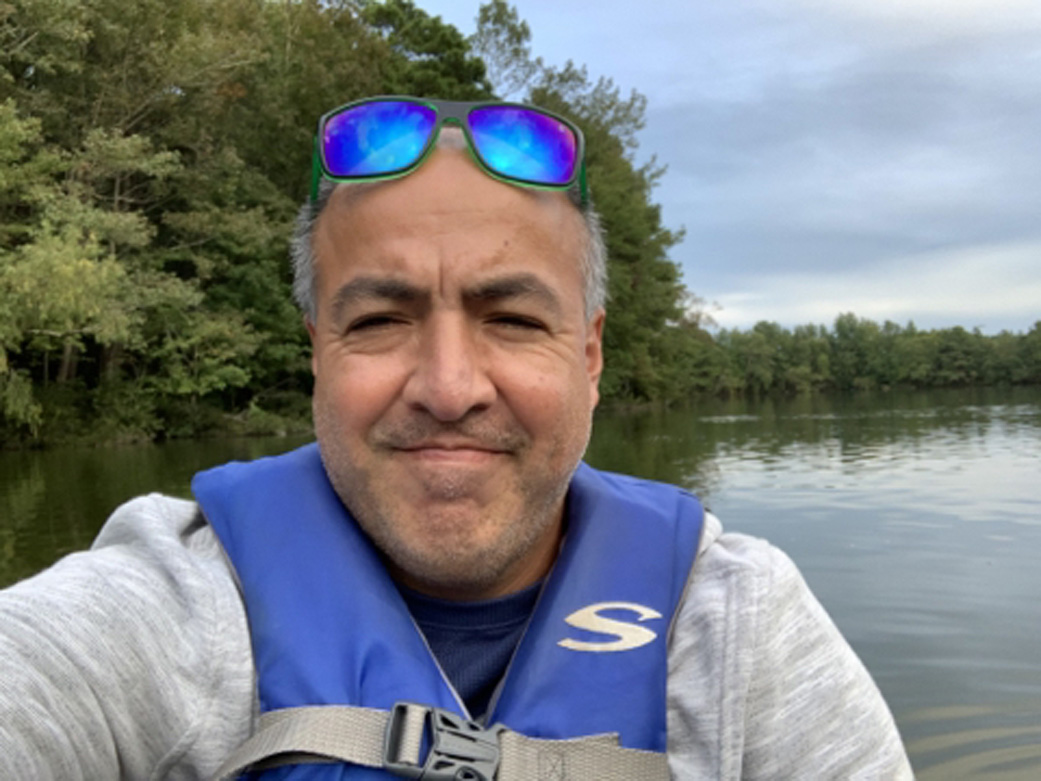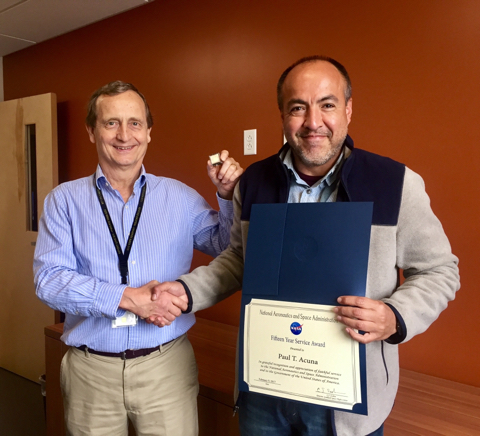Name: Paul Acuna
Title: Electrical engineer
Formal Job Classification: Telecommunications specialist
Organization: IT and Communications Branch, Wallops Flight Facility (Code 780)
What do you do and what is most interesting about your role here at Goddard? How do you help support Goddard’s mission?
I am an electrical engineer supporting Wallops Flight Facility’s IT and Communications Group. I am also the lead engineer for the transition of the copper cable plant to fiber cable plant solution and operation at our facility. Part of my duties also include to support Wallops rocket missions and complete diverse mission telemetry requirements. I have supported all rocket launches at Wallops since joining the IT telecommunication group, and modernized many telecommunication system for our missions to be successful.
Please tell us about growing up in Ecuador?
It was fun! I had a lot of family and friends and I really enjoyed living in Ecuador before coming to the states in December 1990, I arrived in NYC and the first thing I noticed was, it was very cold in the city. In contrast to Ecuador where it was warm, sometimes hot, all year long. I have two brothers, close in age so we are good friends. We grew up in the countryside of Ecuador, played a lot of soccer and competed in local tournaments. Soccer is part of the culture in Ecuador and South America. I also played volleyball and was a runner aficionado. I still play soccer locally.
I went to ESPOL (Escuela Superior Politecnica del Litoral) College in Guayaquil, Ecuador, for two-and-a-half years. My parents were separated, and my brothers and I joined our father in New York; I only planned to stay six months. I took a break from college, got a regular job at a factory, shortly after that, joined the U.S. Navy for two years as a boatswain mate (electrical and mechanical repairman), a seaman. Then I went back to work and decided to complete my education at City College of New York for a bachelor’s and a master’s in electrical engineering.
How did you come to Goddard?
When I was close to completing my master’s, I went to a career fair where I met a NASA representative who arranged an interview with the Wallops chief of engineering. In 2004, after graduation, I came to Goddard as an electrical engineer for the Electrical Engineering Branch at Wallops. I worked on wireless sensors for ultra-duraton research balloons.
How did you get into IT? What is cool about what you do?
In 2008, I was detailed to work with the IT and Communications group to upgrade the communications link between the main base to the island, which is about 10 miles. Back then, the standard was copper lines. We were one of the first to upgrade with communication electronics running on fiber optics, which was far less expensive.
After that project, I was offered a permanent position as a telecommunications specialist, which I accepted. I now do everything relating to telecommunications. Our branch takes care of every single communications system at Wallops, including IP networks, telephone systems, digital television systems, wireless network communications, ground telemetry distribution, and range timing distribution.
We specialize in unique communications projects to replace and upgrade older communications systems. Wallops launches rockets usually with scientific payloads. The payload and rocket send telemetry to our mission control, which ensures that all is well before and after launch. The telemetry routes through our fiber cabler plant and networks to their destination, so what we do links the rocket to the scientists. Some of our research rockets are suborbital and orbital. We also send resupply missions to the International Space Station.
Is there something surprising about you outside of work that people do not generally know?
I am a family man. I have a 9-year-old and a 15-year-old. I am a soccer coach for my son. I also have two mixed Labrador retrievers and we go for many walks.
My wife and I recently bought a house, which we are upgrading together. We enjoy seeing our house become what we want.
Who inspires you?
My teachers from elementary school through my master’s inspired me. They encouraged me to find the best career path for my aptitude. I am very grateful to them. As a young child, I was very good in math, so they encouraged me to become an engineer.
How would you describe yourself?
I am a direct person. I go straight to the point, which is critical when you are working in communications. I am also practical. I look for what works. When, for example, I want to buy a chair, I want a simple chair that is good to sit on at the table. I do not want a chair that has wings and can fly. But I love new technology too, especially in my car.
Conversations With Goddard is a collection of question and answer profiles highlighting the breadth and depth of NASA’s Goddard Space Flight Center’s talented and diverse workforce. The Conversations have been published twice a month since May 2011 and are archived on the NASA Goddard homepage under the People tab.
Banner information:
Magdalena Carmen Frida Kahlo y Calderón (6 July 1907 – 13 July 1954), also known as Frida Kahlo, was a famous Mexican painter known for her many portraits, self-portraits, and works inspired by questions of identity, postcolonialism, gender, class, and race in Mexican society. By the early 1990s, Frida had become not only a recognized figure in art history, but also regarded as an icon for Chicanos, the feminism movement and the LGBTQ+ movement. Kahlo’s work has been celebrated internationally as emblematic of Mexican national and indigenous traditions and by feminists for what is seen as its uncompromising depiction of the female experience and form.
Joseph Michael “Joe” Acabá (born May 17, 1967) is an American educator, hydrogeologist, and NASA astronaut. In May 2004 he became the first person of Puerto Rican heritage to be named as a NASA astronaut candidate, when he was selected as a member of NASA Astronaut Training Group 19. Acabá has logged a total of 306 days in space on three missions. In between missions, Acabá served as the Branch Chief of the International Space Station Operations branch.
Úrsula Hilaria Celia de la Caridad Cruz Alfonso (21 October 1925 – 16 July 2003), known as Celia Cruz, was a Cuban singer and one of the most popular Latin artists of the 20th century. Cruz rose to fame in Cuba during the 1950s as a singer of guarachas, earning the nickname “La Guarachera de Cuba”. In the following decades, she became known internationally as the “Queen of Salsa” due to her contributions to Latin music in the United States.
Sonia Maria Sotomayo is the first woman of color, first Hispanic, and first Latina to be a Supreme Court Justice. During her tenure on the Supreme Court, Sotomayor has been identified with concern for the rights of defendants, calls for reform of the criminal justice system, and making impassioned dissents on issues of race, gender and ethnic identity.
By Elizabeth M. Jarrell
NASA’s Goddard Space Flight Center































